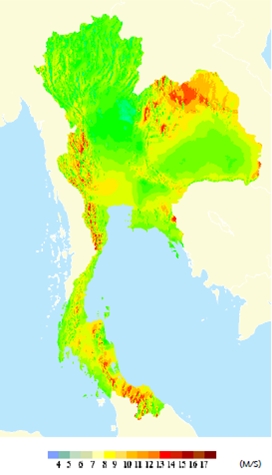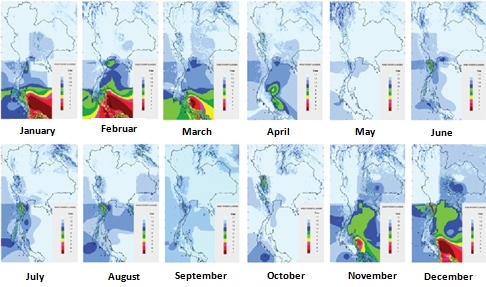Wind power and its potential in Thailand

Wind power is one of clean and renewable natural sources of energy. In order to use wind power, we need wind turbines to convert kinetic energy from the wind into mechanical energy and consequently use that energy in pumping water or generate electricity.
Thailand foresees the significance of wind power and develops it into one of alternative energy sources to substitute fossil-based energy. The Ministry of Energy’s Department of Alternative Energy Development and Efficiency, or DEDE, has conducted studies on the potential of wind power since 1975. At present, it has a total of 70 wind measurement stations, 23 of which at the height of 90 meters and the remainder 47 meters at the height of 40 meters. It plans to upgrade all the existing measurement stations to the height of 90 meters.
Key activities regarding wind power potential survey in Thailand over the past years include the conduct of a map in 2001 that demonstrated wind power potential in Thailand, based on DEDE’s wind speed statistics at the 10-meter height wind measurement posts and from other data sources. The survey found that potential wind power sources located in the Gulf of Thailand--from Nakornsritammarat, Songkla, to Pattany-- as well as some area in Petchburi and Doi Intanon, with an average wind speed of 6.4 meters per second at 50-meter height.
According to a study on wind power potential at the five provinces conducted on the same year, area with potential for wind farm establishment was Nern kuan see pan at Kohyai, krasae sindh, Songkhla, with the average wind speed of 5.3 meters per second.
In order to develop wind power potential in Thailand, the DEDE has in 2009 upgraded the map of Thailand’s wind power potential to make it more accurate and up to date.
To demonstrate wind power potential of each area in Thailand during respective months, crimson area shows area with highest wind power potential.


The map of Wind power and its potential in Thailand in each month
That was the beginning of the demonstration of potential and continuous development of wind power in Thailand that paved way for the country’s current and accurate map of wind power potential which lay fundamentals for future studies on the subject.


